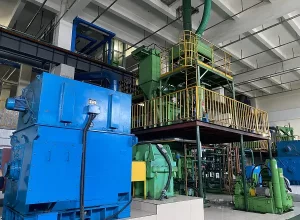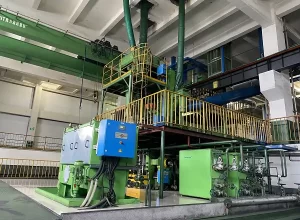
The electromagnetic fields in PMSMs are equally dependent on design architecture, material selection, and operating conditions. The rotor and stator geometry, pole arrangement, etc. affect the magnetic field distribution. Finally, the impact of materials is major as well with essential magnetic fluxes and field strengths depending on topologically rare-earth magnets or more electrical steel. Similarly, the magnetic characteristics of materials are altered by environmental conditions, such as temperature changes that also affect motor performance and efficiency.
Computational methods especially Finite Element Analysis (FEA) are used to analyze and optimum electromagnetic field in PMSMs. FEA allows for determining the behavior of magnetic fields under various operating conditions and also allows for predicting motor performance before building any physical prototype. Such simulations allow engineers to visualize pathways for magnetic flux, tag potential electrical losses, and pinpoint areas of the design that could be improved: all factors contributing to more efficient permanent magnet AC synchronous motors.
Experimental methods are necessary to validate the computational models of PMSMs. For external validation of the numerical simulations, magnetic sensors such as the Hall effect sensor or fluxgate magnetometer can be used to measure the magnetic fields. Prototypes are tested in controlled environments and motor performance parameters along with unexpected behaviors identified. By correlating experimental data with theoretical calculations, this aids in improving design methods and optimal electromagnetic configurations.
Various advanced software tools are frequently used to simulate the electromagnetic fields in PMSMs, including ANSYS Maxwell, COMSOL Multiphysics, and JMAG. They allow the quantity, and modeling of complex geometry, and material property variation with detailed electromagnetic interaction insight inside these types of motors. This is particularly true for permanent magnet AC synchronous motors because the cost of producing a physical prototype can be high; using software for simulation allows engineers to iterate quickly on designs, reducing time and development costs.

Analysis of electromagnetic fields is difficult due to the characteristics of materials used in PMSMs. Discrepancies between simulation and actual motor performance can arise from variability in the magnetic and electrical characteristics of materials. Magnetic-related phenomena such as saturation of the used magnetic materials directly influence field distribution and may yield very optimized designs that ultimately perform poorly under device operating conditions. Hence, accurate electromagnetic field analysis is reliant on material testing and characterization.
The electricity of PMSMs generally has a complicated geometrical shape and that leads to easier and harder electromagnetic field analysis. Automatic geometry creation for rotors and stators becomes quite challenging, particularly for multi-pole types in which the rest of the winding needs to be represented using some kind of symmetry. Getting the details of these geometries is important to accurately predict how a magnetic field will act. This leads to a trade-off that engineers must grapple with, between modeling such complex designs to improve performance and the associated resource demand to model these systems properly.
Thermal effects strongly affect the electromagnetic performance of PMSMs. Temperature-dependent magnetic properties of materials can change the distribution of electromagnetic fields inside the motor. Higher temperatures usually cause a magnet to lose its strength and therefore, loss of motor efficiency. Accurately monitoring and testing these thermal impacts can assist in characterizing motors such that they are resistant to any performance compromises across a varying range of thermal conditions.
Permanent magnet materials have been developed that considerably raised the performance of PMSMs. Some recent developments are with the formulation of next-generation high-energy-density magnets, especially those that are mainly made out of rare-earth elements that lower the size of motors while increasing the output magnetic flux. This higher coercivity enables these magnets to be functional at elevated temperatures where longer operational stability and reliability are required. Such an innovation is essential since it directly contributes to motor efficiency, eventually leading to lower energy consumption and enhanced sustainability of application areas from several sectors.
In addition to that, other magnetic materials such as nanocrystalline and composite magnets are receiving increased interest owing to their unique magnetic properties which can reduce the cost of production and offer improved performance characteristics. In addition to better efficiencies, these new materials have lower weight and volume footprint, which is becoming more important in electric vehicle and aerospace applications. Hence, material innovation enables size and volume reduction in Permanent Magnet AC Synchronous Motors.

Research efforts have been devoted to the development of innovative control algorithms for PMSMs considering their important role in improving power efficiency and enabling smooth operation. Some of the control strategies such as FOC (Field-Oriented Control) and DTC (Direct Torque Control) have been developed, which give accurate control of torque and speed. Such schemes respond to load changes instantaneously, enhancing the control accuracy and dynamic performance of Permanent Magnet AC Synchronous Motors.
Additionally, the incorporation of artificial intelligence and machine learning approaches into control systems is changing PMSM usage via predictive maintenance and on-the-go modifications. These are significant for energy consumption optimization and motor or component life extension. With the help of frustrated algorithms, manufacturers can exploit PMSMs in several application areas providing high performance and operational life.
PMSMs have been, to a large extent, affected by the evolution of electric vehicles (EVs), since they are often used in EV applications. With the increasing global need for sustainable transportation solutions, electric propulsion systems and in particular Permanent Magnet AC Synchronous Motors are coming into focus. Special features of PMSM motors make them highly efficient, and lightweight, and with a powerful torque-to-weight ratio personal vehicles can achieve much longer distances for the same amount of energy, getting better range and acceleration capabilities.
Since one vehicle model always has different requirements — think two-wheeler to heavy-duty truck, for example — there is also more and more focus on modular and scalable PMSM designs. Integrated electric drive systems, which combine the motor with the inverter and gearbox into one unit, are also being introduced to optimize space and weight even further. Such development not only facilitates the growth of electric mobility but also emphasizes the wide application possibilities of PMSMs in various transport systems.
Qingdao Enneng Motor Co., Ltd is the company to go for Ponded PMSM technology with innovation, quality, and customer service. The company is driven by its mission to provide efficient high-efficiency motor solutions, focusing on state-of-the-art PMSM development to meet the changing requirements of industries. Through R&D, Qingdao Enneng continuously improves the performance, reliability, and efficiency of electric motor systems.
Reductions in industrial kilowatt hours are significant when you look at how the company focuses on eco-friendly manufacturing processes and energy-efficient products. They are also known for high-performance engineering and customer-oriented services that make them stand out from the competition. With Enneng, collaborative relationships that they develop with clients and stakeholders will enable them to drive technological advancements which will help spread the use of PMSMs.
High-performance Permanent Magnet Synchronous Motors can be optimized with proper electromagnetic field simulations towards obtaining desired efficiency. Given ongoing innovations in materials, control algorithms, and applications within the industry it becomes clear that field analysis paired with state-of-the-art technology is necessary to propel these motors into their next chapter.
As the world identifies efficiency and sustainable technology, the trends seen among electric vehicle applications will continue to have a significant role in optimally designing PMSMs. With innovative offerings backed by a commitment to quality, companies including Qingdao Enneng Motor Co., Ltd are setting the bar high in the PMSM domain. Hence, the continuous collaboration between research and industry as well as application is essential to achieving a complete capability in Permanent Magnet AC Synchronous Motors for all fields of work toward a more efficient and greening future.